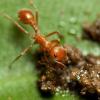Scientific Name: Formica podzolica
Common Name: Black lawn ant
Distribution: Found throughout Canada and northern areas of the United States.
Queen size: 7-8 mm
Worker size: 4-7 mm
Natural Habitat: Commonly found in the middle of fields or along the tree line by spruce or aspen facing the sun.
Circadian Activity: Primarily Diurnal and quite active during the day.
Mating Flight: Late July to Late August. They usually fly between 1pm and 6pm. In some locations they have one massive flight and several smaller ones.
Queen Founding Method: Fully Claustral
Monogyne or Polygyne: Monogyne
Average time from egg to worker: Can widely vary depending on temperature. Egg to Larvae = 10-20 days; Larvae to pupae = 8-12 days, Pupae to worker = 5-15 days. Brood in this species grows faster than most in Alberta. They never overwinter brood.
Recommended Temperature: Preferred Summer temperatures are 22-26C (71.6-78.8F)
Recommended Humidity: This species likes it moderately damp, they do not do well if their nest gets on the drier side.
Preferred Foods: This species loves almost any insect and any sweet. Hummingbird nectar, sugar water, crickets, mealworms, various fly species, etc. They do have a preference for foods that they can carry into the nest. This species does have a social stomach.
Hibernation Details: Formica podzolica require hibernation. They need 3-4 months in the fridge, preferred hibernation temperatures are 8-15C (46.4-59F). They can survive as low as 3C (37.4F), but deaths can start occurring. Depending on the local climate, hibernation times can go up to 7 months in length.
Escape Barrier Methods: Olive oil, talc, and fluon work for this species. Vaseline does not affect them.
Difficulty rating: This species is a fairly easy species as it grows quite quickly, eats almost anything, and is forgiving of mistakes (just donβt let the humidity go too low).
Bite and/or Sting rating: This species can bite and they are also able to place droplets of formic acid into a bite mark or on other surfaces. It can be a bit painful while they are biting, but it fades quickly.
Special Care or Interesting Notes: This species is not able to βsprayβ formic acid, although vapors from the formic acid can cause issues with large colonies in poorly ventilated formicariums. This species is often found tending aphids. Low humidity can cause issues with this species, particularly with the brood. They often build dirt mounds and frequently cover them with spruce or pine needles. They are easily spooked by vibration, shadows passing overhead, or mammal breath.
Additional Links:
http://www.antweb.or...ecies=podzolica
http://www.antwiki.o...rmica_podzolica
http://www.navajonat...-podzolica.html
http://www.insectsof...a-podzolica.htm
Information submitted by Crystals
Edited by dspdrew, March 5 2022 - 7:18 PM.
























